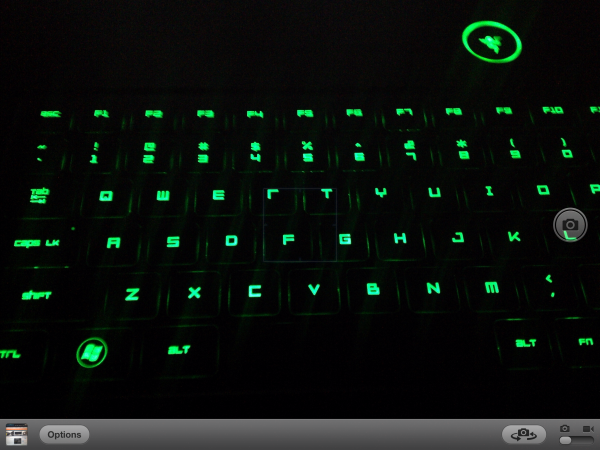The Apple iPad Review (2012)
by Vivek Gowri & Anand Lal Shimpi on March 28, 2012 3:14 PM ESTThe Camera, It's Much Improved
by Vivek Gowri
iOS 5.1 brought with it a number of bugfixes along with a few minor changes to the core entertainment applications (Music, Photos, Videos), but the only real UI change it brought was the redesigned camera application for the iPad. It fixes our biggest complaint with the original—the shutter button’s location in the middle of the settings bar at the bottom of the screen—and ends up being a big improvement from a usability standpoint. The shutter now resides in a floating circular button on the right side of the display, right where your right thumb falls when holding the iPad with two hands. It’s a more intuitive location for the shutter, so taking a picture is a far more natural feeling exercise than it was before. Other than that, the app looks pretty similar—the settings bar now has the still/video slider, front/rear camera switch, an options button, and the link to the photo gallery.
In terms of camera options, there’s only one. You can either have the rule of thirds grid overlay visible or hidden....and that’s it. There’s no other settings for you to change. No exposure, white balance, ISO, shutter speed, or anything else that isn’t the shutter button. Unfortunately, even the HDR mode from the 4 and 4S is nowhere to be found on the iPad. You literally just point and shoot. That’s all there is for you to do.
In our review of the iPad 2, we summed up the cameras with just one word, mediocre. Looking back, I realize now that the word mediocre is a pretty charitable way to describe the iPad 2’s camera situation. Both sensors were borrowed from the iPod touch, and while the VGA front facing camera was acceptable, the rear facing 720p camera was legitimately bad by the standards of a $499 device.
The new iPad fixes that rear camera problem in a big way, with the five element f/2.4 lens and optics borrowed from the iPhone 4S paired with the Omnivision OV5650 CMOS image sensor from the iPhone 4. A quick refresher on specs: 5 megapixels, backside illuminated, 1080p video at 60fps. If you ignore megapixel count, it’s a pretty competitive camera on paper. There’s a lot of recycled parts here, with bits and pieces from other iDevices frankensteined together to come up with a new imaging system for the iPad, but parts-bin raids aren’t bad when the bins being raided from contain top-tier components. The result ends up being pretty good—as a camera, the new iPad is light years ahead of its predecessor in basically every way.
In practice, it’s nothing short of stellar. Image quality is comparable to most high end smartphones, though not quite good enough to be on par with the bleeding edge cameraphones (4S, Nokia N8/N9, HTC Amaze 4G, Galaxy S 2, etc). Interestingly enough, the preview image looks to be running below 30 fps, appearing a little bit choppy at times. This is likely due to the high resolution of the preview and upscaling it to a very high display resolution, but it doesn’t particularly affect image capture. I measured shot to shot time at exactly one second (I had a range between 0.98 and 1.04 seconds, averaged out to 1.0 when factoring in reaction time). That’s about double what Apple claimed for the 4S, and a bit longer than the iPad 2. Granted, the iPad 2’s camera was very quick in part because the amount of processing it takes to capture a 960x720 image is almost zero, with about 13.8% as many pixels as each 2592x1936 image captured by the new iPad.
The focal length is 4.28mm, a bit longer than the iPad 2’s 3.85mm. The difference is actually noticeable; when taking pictures of nearby subjects, you’re sometimes surprised by how magnified the subject appears. However, the camera is good for landscapes, as you can see from the sample gallery. I took the iPad with me on a weekend trip to Victoria, B.C. and used it as my primary camera on the trip. Now, while I wouldn’t trade my SLR for an iPad anytime soon, I can’t deny that the results turned out pretty well. Colours were vibrant, white balance was accurate, and the clouds were nicely highlighted. It’s a quantum leap from the noisy, 0.7MP mess that was the iPad 2 camera. Mouse over the links below to see some comparisons between the cameras on the iPad 2, 3rd gen iPad and TF Prime.

| Apple iPad 2 | Apple iPad (3rd gen) | ASUS TF Prime |
| original | original | original |

| Apple iPad 2 | Apple iPad (3rd gen) | ASUS TF Prime |
| original | original | original |
The new sensor can record 1080p video, up from 720p. Video quality was probably the best aspect of the iPad 2 camera, and it's even better here. Output is recorded at 29.970 fps and encoded in h.264 Baseline with a bitrate of 21Mbps and single channel audio at 64kbps. The recorded video impresses, with crisp detailing and adequate audio quality from the single mic.
The front facing camera keeps the Omnivision OV297AA sensor from the iPad 2, and as such, image and video quality remain unchanged. It’s not necessarily a bad thing, since it remains adequate for FaceTime and Skype, but it would have been nice to see an update to an HD-quality webcam up front.
With augmented reality apps, I’m starting to see the benefit of rear cameras on tablets. For example, the Yelp app, which takes location and compass data to display what restaurants are the direction the iPad is pointing, with a real-time street view of the search results. It’s not necessarily the most useful way to use the rear facing camera in an AR application, but overall it’s an idea that has potential. Apple also tells us that its business and education customers see usefulness in the iPad's rear facing camera as they can use it to quickly document something while using the iPad as a productivity tool. As a consumer, you’re going to get weird looks if you’re using the iPad to take pictures though, it’s a relatively comical sight.
And that’s really the problem: from an ergonomic standpoint, smartphones are just so much easier and more comfortable to use as cameras. And because the imaging hardware is so similar, I’m not sure I see the real benefit of having a rear facing camera on a tablet except in very specific use cases.

























234 Comments
View All Comments
damianrobertjones - Thursday, March 29, 2012 - link
" It's got everything but the kitchen sink. "SD card reader?
USB port?
Ethernet port?
Removable battery?
Move files straight from the device to a pc without ANY software?
The list could go on.
darkcrayon - Thursday, March 29, 2012 - link
But there is n WIFI, optional LTE, Bluetooth 4, and a dock connector (which includes USB) to handle many similar functions.mr_ripley - Thursday, March 29, 2012 - link
oh, and also:a slot to plug in my punch cards and floppy discs
and it would be nice if it had disc drive so i could play my audio cds
maybe connect to dial up modems too
......
all because i could not move on to better ways of doing things. All of what you mention is either obsolete or redundant!!
dagamer34 - Friday, March 30, 2012 - link
I think you want a laptop....jihe - Thursday, March 29, 2012 - link
"I said I wanted to give it a shot at being a real productivity device"That is where you went wrong. Pads are toys and nothing more.
repoman27 - Thursday, March 29, 2012 - link
You might want to try running that last statement by a pilot, doctor or teacher. They're not terribly optimized for content creation at this point, but if you think that their value does not extend beyond mere entertainment, then you really haven't considered the possible use cases for these devices.mavere - Friday, March 30, 2012 - link
Don't forget lawyers.Lots and lots of trees have been saved since the iPad's introduction.
neoabraxas - Thursday, March 29, 2012 - link
I find it absolutely ridiculous that someone who does not appreciate the tablet form factor is offering their thoughts on the new iPad.Is there really nobody at Anandtech who genuinely enjoys tablets and can write a summary that is aimed more at tablet enthusiasts?
Bloggers like you do tend to write a lot on their devices. Most people don't. For them tablets are media consumption devices. I'm a programmer. When I get home the last thing I want to do with my computing equipment is type more. For me a tablet is ideal.
vol7ron - Thursday, March 29, 2012 - link
To be honest, the last thing I want to do on a tablet/smartphone is type. Unless, it's with the Transformer (or other like) keyboard, but even then it's still not what I want to use a tablet for.The main thing, for me, is reading.
MrCromulent - Thursday, March 29, 2012 - link
Great review! I was looking forward to reading it when I saw it posted yesterday evening.One point I'm missing from every review though: Has the touchscreen sensitivity / resolution changed in any way? The doubling of display resolution does not imply doubling of the touch input resolution, right? I love the iPad, but I always found it almost unusable for any kind of handwritten input (be it finger or stylus).